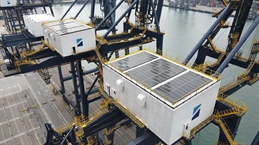
Hongkong International Terminals (HIT) announced the arrival of two brand new quay cranes, representing an investment of HK$78 million, which are Hong Kong's first quay cranes equipped with solar panels on top of machinery house.
The Hong Kong container terminal said this is a "significant milestone" in the industry as HIT continues its efforts to explore new alternatives to reduce its operational impacts on the environment and become a green port.
It also contributes to the Hong Kong government's Climate Action Plan 2050 with an aim towards carbon neutrality.
"HIT is committed to managing its carbon footprints by exploring environmentally sustainable alternatives," said Ivor Chow, managing director of HIT.
"With the installation of solar panels on quay cranes, we are glad to be taking our green mission to the next level and supporting Hong Kong in becoming a low-carbon and green city."
Chow said looking ahead, HIT will continue its endeavours in optimising terminal facilities and exploring other applications of renewable energy to build a sustainable port ecosystem.
HIT said the photovoltaic system, comprising 84 solar panels, has been installed on the quay cranes.
Energy collected will be used to power auxiliary systems, including air conditioning and lighting systems in the quay cranes.
With an estimated 3 hours of exposure to sunlight every day, the photovoltaic system on quay cranes will be able to generate roughly 42,000Wh of energy with a 98.75% system efficiency.
HIT noted that along with the solar panels previously installed in 8 car parks and 24 substations, the accumulated total energy generated would be over 1.6 million kWh per year, which is equivalent to the amount of energy needed to charge roughly 3,920 electric cars for a month or 875,000 smartphones for a year.
In 2022, Hutchison Port Holdings Trust reported an emissions intensity of 11.790 (kg CO2e/Twenty-foot Equivalent Unit), representing a decrease of 17% compared to 2021.
HIT said aside from solar energy, it has also adopted a series of measures in energy saving and emissions reduction, including deploying electric vehicles, converting hybrid power systems of rubber-tyred gantry cranes to electric systems as well as promoting the efficient use of electricity consumption.



